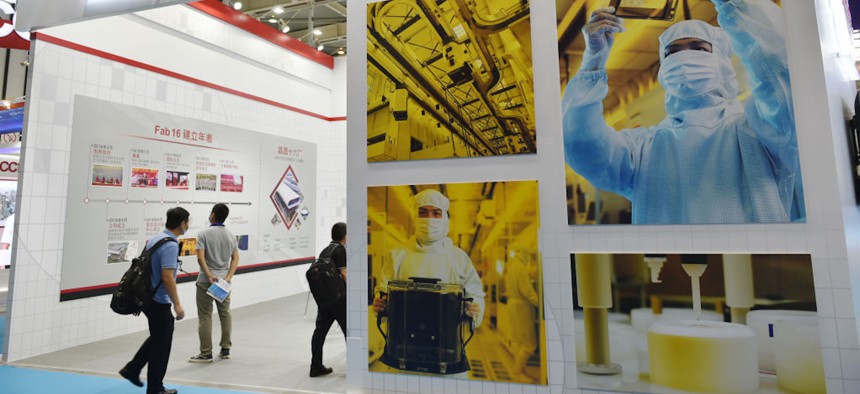
: People visit Taiwan Semiconductor Manufacturing Company (TSMC) booth during 2020 World Semiconductor Conference at the Nanjing International Expo Center on August 27, 2020 in Nanjing, Jiangsu Province of China
US Chips Are Paving China’s Path to AI Superiority and There’s No Easy Fix
The Chinese military obtains them through intermediaries and dummy corporations.
Chips designed by U.S. companies are helping China work toward its goal of becoming the world leader in artificial intelligence by 2030, according to a new report out this week from the Center for Security in Emerging Technology, or CSET. But fixing that isn’t as simple as just passing new controls.
Some 97 public records of Chinese military purchases of AI chips show that “nearly all of them were designed by Nvidia, Xilinx (now AMD), Intel, or Microsemi”—all U.S. companies, the researchers wrote. “By comparison, we could not find any public records of [Chinese military] units or stateowned defense enterprises placing orders for high-end AI chips designed by Chinese companies, such as HiSilicon (Huawei), Sugon, Sunway, Hygon, or Phytium.”
Moreover, those U-S-designed chips are largely manufactured in bulk by Asian companies such as Samsung in South Korea and the Taiwan Semiconductor Manufacturing Company in Taiwan—the self-governing island that U.S. Indo-Pacific Command leaders say could be invaded by China in the next five years.
Graphics processor units, or GPUs, designed by Nvidia are the international market leader in chips to run complex artificial intelligence applications. While the Chinese government has spent heavily to develop its own chips, the report says, “High barriers to entry, including a reliance on intrinsic knowledge and highly specialized equipment, have so far prevented Chinese companies from catching up.”
In 2020, the Trump administration imposed restrictions to keep U.S. chip designs out of China; the Biden administration has maintained those controls. But that hasn’t stopped the Chinese military from obtaining chips through a variety of avenues, including purchases by Chinese intermediaries and, in some cases, by setting up dummy corporations.
To curb the problem, the U.S. government could look at more controls but without a ramp up in the government’s enforcement and investigation capabilities, new controls by themselves likely won’t achieve their desired effect. “Chips themselves are hard to track. Although they are technically sophisticated, physical inputs to AI development, chips in transit do not carry an easily observable signature,” the authors write.
Instead, they say, the Commerce Department should should work with industry to better identify what chips might be most relevant to the Chinese military’s AI goals and “coordinate with partners to screen intended end-users and prevent their export.” And the U.S. intelligence community should bulk up its analysis of open source intelligence on Chinese chip contracts. The CSET researchers “identified seven Chinese military vendors which are not listed in U.S. end-user export control regimes. There is room for open-source analysis to address other security challenges.”
Taiwanese manufacturers are also pressing the United States for subsidies to speed the process of building new manufacturing facilities in the United States.
In January 2021, Congress passed the CHIPS Act–as part of the FY 2021 National Defense Authorization Act–to secure almost $52 billion to incentive the develop of chip manufacturing in the United States. But chip makers have complained that the funds aren’t moving fast enough.
